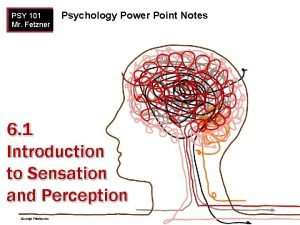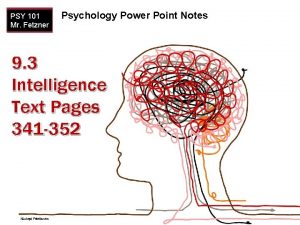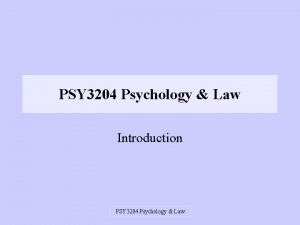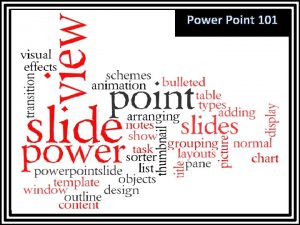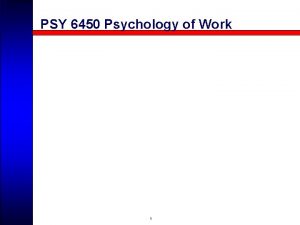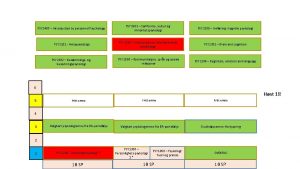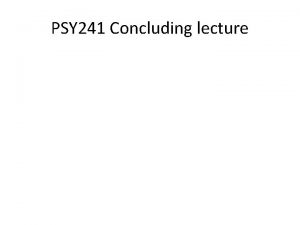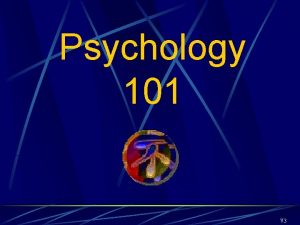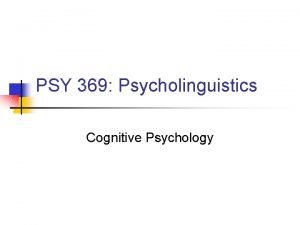PSY 101 Mr Fetzner Psychology Power Point Notes













- Slides: 13

PSY 101 Mr. Fetzner Psychology Power Point Notes 6. 1 Introduction to Sensation and Perception NLshop/ Fotolia. com

4 Sensation and Perception 5 Bottom-up Processing, Top-down Processing 9 Psychophysics 10 -11 13 Thresholds Sensory Adaptation NLshop/ Fotolia. com Table of Contents

Fact or Falsehood? Patients who have negative expectations about the outcome of a surgical procedure may experience increased postoperative pain. true Subliminal messages can raise our self-esteem and improve our memories. false Most people cannot quickly make sense of words on a page. true

Perception Sensation How we make sense of the data Data coming in Faces? Horses? What did you SENSE on this slide? What did you PERCEIVE on this slide? Rocks?

Rich. Hemera/ Reid/Getty Thinkstock Images Bottom-up Processing § Sensory receptors relay information to the brain § The brain interprets this information Top-down Processing § Previous experience and expectations affect the detection and analysis of information from the senses § Explains visual illusions How is the child using bottomup processing of sensory information?

Hemera/ Thinkstock How are you bottom-up processing AND top-down processing as you make sense of this figure? What areas of the brain and/or visual sensory system result in this illusion? In other words, what does this apparent “malfunction” in visual perception tell us about how our visual system operates? How might the processes which lead to this illusion be adaptive in normal, everyday situations?

Barbara Penoyar/ Thinkstock Exercise Change the position of your watch, put a book on your lap, put your phone in a different pocket or put a pencil behind your ear. Comstock/ Thinkstock i. Stockphoto / Thinkstock

Psychophysics Methods that measure the strength of a stimulus and the observer’s sensitivity to the stimulus AJPhoto / Photo Researchers, Inc. / Science Source

Absolute Threshold Minimum stimulus necessary to detect a stimulus half of the time liquidlibrary / Thinkstock

Minimal change in a stimulus that can just barely be detected You’re a bit flat! Weber’s Law: For a difference to be perceptible, two stimuli must differ by a constant proportion, rather than amount Creatas / Thinkstock Difference Threshold (Just Noticeable Difference or JND)

Which red box is darker than the other two?

Feel anything unusual? Sensory adaptation Something you adjusted earlier? Diminishing sensitivity to an unchanging stimulus Benefit—freedom to focus on informative changes without uninformative background stimulation We perceive the world not as it actually is, but as it is useful for us to perceive it. Photo credits, clockwise from top left: Barbara Penoyar/ Thinkstock; Comstock/ Thinkstock; i. Stockphoto/ Thinkstock

The detection of environmental stimuli, such as sounds, objects and smells Perception The experience of detecting those environmental stimuli—it refers to how our brains organize and interpret sounds, objects and smells. i. Stockphoto / Thinkstock Sensation Ouch! I won’t do that again! Hemera/ Thinkstock What is the Difference Between Sensation and Perception?
